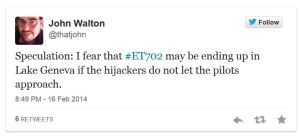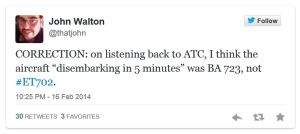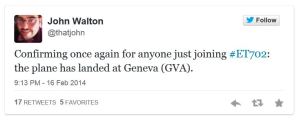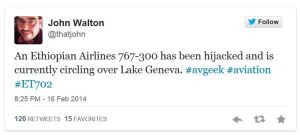After a brief tweet to congratulate John Walton (@thatjohn) for breaking the #ET702 hijacking story and alert him to my initial post on the matter, we got into a Twitter, then email conversation, and then a live chat with the students of the Journalism & Democracy capstone class, each discussion giving a little more texture to his experience and learning about reporting a story as it happens using Twitter as a publication medium.
His insights are intriguing, and he tells the behind-the-scenes story on how he investigated and reported the story in real time it what is certainly the best example of real-time Social Journalism to date.
In the story and our conversations, he confirms some of the ideas and instincts that I am exploring in my work as a Fellow at the Reynolds Journalism Institute. Both tacitly and explicitly, he endorses the concept that readers need to be as aware of the progress of the reporting as they are of the news itself, something I champion with #CommonTags. He also offers guidelines from his first-hand experience that will contribute to the Social Journalism Policy handbook, a work in progress by the excellent capstone students who are reaching out to newsrooms and bloggers to identify the intersection of newsroom ethics and social media best practices.
Walton may not be the first journalist to break a story via Twitter, but he is quite likely the most introspective of the experience. And at a time when – as the j-school students were told today – many mainstream papers specifically prohibit their reporters from breaking stories using Twitter – the lessons we can take away from the #ET702 story are bound to shape the practice, if not the predominance, of real-time news reporting.
In our conversations and in his story-behind-the-story account, Walton calls out “learning points,” a number of which are worth highlighting here, in hopes that they might also trigger further discussion.
140 Characters Is Enough. In a discussion of the use of #CommonTags, a few students made the case that the use of hashtags, while potentially important, had to be weighed against the overall scarcity of space in which to report a news item. Tags, the students argued, take of valuable characters that could otherwise be used to tell the story. On this topic, Walton had a clear view: the 140-character restriction of Twitter a plus in reporting real-time news. The limitation forces the journalist to focus on specific facts, being careful to optimize for concise clarity. “State facts as you know them, and briefly,” he told me. “The 140-character medium is more help than hindrance here. Be succinct.”
 Hashtags work. Throughout his reporting, and without awareness of the #CommonTag.org project, Walton adopted tags to bring clarity to what was known, speculated, recapped, and corrected during the course of his reporting. While he didn’t use the hashtag (#) as a search mechanism, he readily used keywords such as Speculation, Unconfirmed, What We Know, and Correction to help readers work their way through his stream of real-time reporting. In our follow up conversation, Walton wrote, “Tweet current state of play regularly (“To confirm, the plane is on the ground”), especially if earlier tweets (“the plane is in the air”) are being retweeted.”
Hashtags work. Throughout his reporting, and without awareness of the #CommonTag.org project, Walton adopted tags to bring clarity to what was known, speculated, recapped, and corrected during the course of his reporting. While he didn’t use the hashtag (#) as a search mechanism, he readily used keywords such as Speculation, Unconfirmed, What We Know, and Correction to help readers work their way through his stream of real-time reporting. In our follow up conversation, Walton wrote, “Tweet current state of play regularly (“To confirm, the plane is on the ground”), especially if earlier tweets (“the plane is in the air”) are being retweeted.”
Corrections and Transparency. Throughout the evening, Walton was careful to note when information was factual and when it was speculation, as you can see in the image above. In the heat of a breaking story, however, you may not get everything right. When that happens, as it did when Walton says he misheard the “BA flight “Speedbird 723” for ET702,” Walton is clear: “Issue corrections and remove the wrong tweets to reduce the retweeting of incorrect info.”
 When challenged by our students who suggested that removing a tweet may contradict the obligation to be transparent, Walton didn’t hedge. “Transparency is important, and that’s why I clearly marked tweets as corrections,” he said. “If you leave the mis-information out there, it will get re-tweeted, so for the accuracy of the story, you have to take it down.”
When challenged by our students who suggested that removing a tweet may contradict the obligation to be transparent, Walton didn’t hedge. “Transparency is important, and that’s why I clearly marked tweets as corrections,” he said. “If you leave the mis-information out there, it will get re-tweeted, so for the accuracy of the story, you have to take it down.”
 The Recap Imperative Social media is a fire hose, to be sure, and as #ET702 began to trend on Twitter, Walton recognized that he had become “a primary source for this information.” Knowing that people would be jumping into the story mid-stream, he “needed to bring people just joining the story up to speed.” Walton frequently recapped what he know so that newcomers could quickly see the scope of the story. He used clear language, as in the image on the right, as well as the leading phrase What We Know to frequently summarize key points of the story.
The Recap Imperative Social media is a fire hose, to be sure, and as #ET702 began to trend on Twitter, Walton recognized that he had become “a primary source for this information.” Knowing that people would be jumping into the story mid-stream, he “needed to bring people just joining the story up to speed.” Walton frequently recapped what he know so that newcomers could quickly see the scope of the story. He used clear language, as in the image on the right, as well as the leading phrase What We Know to frequently summarize key points of the story.
Specialists Trump Generalists. In his recounting of the news event, Walton gives great detail about how he discovered, verified, and ultimately reported the story. What becomes clear quickly is that Walton’s passion for and knowledge of aviation put him in the right place at the right time to break this story. As he spoke to the class this afternoon, Walton expressed his belief that it will become increasingly important for journalists to be deeply specialized in order to report real-time stories with speed and accuracy. Indeed, he envisions a sort of two-tiered journalism hierarchy where specialists become the source for general news outlets.
In fact, that’s just what happened in the #ET702 story. General news outlets picked up on the trending story, and several reporters soon identified Walton as an expert source for their stories. To those reporters, he had this advice: “Twitter as a channel is overwhelming during an event like this. My email address was available publicly; despite a load of ‘please follow and DM’ requests, only one outlet emailed me. That outlet got a better response because it was easier to take it off Twitter.”
He went on to school reporters on fundamentals that were apparently lost in the rush to hop on the story. “Learn how to get answers to the questions you don’t know how to ask,” he said. “I’m unusual as a subject matter expert in that I’ve had journalist training; I know how to steer the conversation to what will be interesting for your audience. Most experts don’t have that. Your anchor or presenter probably isn’t an expert on this, and they need to proceed quickly from the “can you tell us what’s going on” to ‘why is that important’ and ‘what does this mean.’ ‘
Sometimes the Crowd Can Help. While many mainstream media find Twitter crowded and noisy, those crowds can be useful in unpacking a story, particularly one filled with technical or specialist knowledge. Writes Walton, “Don’t be afraid of being specific. If ‘ILS glideslope’ is relevant and precise, tweet about it. Others in the conversation will explain, or people can Google for themselves. If it’s complicated, you can point to an independent source like Wikipedia (as I did for transponder codes). Yet be as helpful as you can: needless jargon doesn’t help wider understanding.”
But Remind the Crowd of Your Place in It. As a trending story takes on a life of its own, it becomes important to remind the audience who you are and why you are qualified to report the story. Writes Walton, “Once you start being retweeted significantly, state your credentials and situation regularly. Several Twitter users assumed I was tweeting from the plane.”
As we learned from the Boston Marathon bombing tweet stream and the Washington Navy Year shooting coverage, real-time reporting is a work in progress. With the #ET702 story, it’s clear we are progressing to a better standard of journalism about these fast-evolving events.
